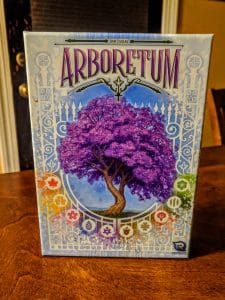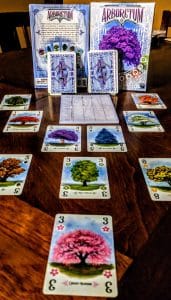Every year around this time (September, to be exact), I start to get very excited. No, I have not been waiting all year for the return of the coveted Pumpkin Spice Latte; I am shivering with anticipation of the arrival of Autumn, signaled by the changing of the leaves.
Living but a stone’s throw from the foothills of the Great Smoky Mountains, I have always had a front row seat to the beautiful display of vibrant oranges, reds, yellows, and browns that makeup the breathtaking mosaic of maple, birch, oak, and other trees.
Naturally, when I set eyes on the vivid colors and exquisite artwork of Arboretum, it immediately captured my interest; I almost didn’t need to hear any details about the gameplay, because I wanted to look at the illustrations so badly. Designer Dan Cassar and artist Beth Sobel have crafted a nature-lover’s momentary getaway with nothing other than a pack of cards!
Depending on the number of players (the game accommodates 2 to 4), each will choose from a selection of tree types (there are 10 total) with numbers ranging from 1 to 8, planting some in the arboretum and discarding others, all while keeping enough of each type in your hand to win the points for that species in the end.
Every time I play, I find myself wanting just a little bit longer to get lost in the trees.
Arboretum: The Roots
The only thing required to play (and fall in love with) this beautiful game is your cards, the scorecard, and a really big table; no, really. My husband and I have a pretty decently large dining room table (let’s be honest, it’s our gaming table now), and we had to do quite a bit of card-compressing to get our arboretum spreads to fit. We might have to switch up our seating arrangements a bit and each take a seat at the head of the table to leave enough room for each of our peaceful pathways to sprawl out as intended!
Arboretum: Branching Out
The gameplay is pretty simple, but the strategy can be quite complicated; all players start with 7 cards in their hand, and will end each turn with 7 cards. Each round, players will draw two cards, placing one of the total 9 cards in their arboretum, and discarding one; cards can be drawn from the deck, or from the top of the discard piles of the other players. These might seem like simple decisions to make, but trust me. They can make or break the success of the arboretum you build, so beware!
The specifics and limitations of planting your trees are pretty easy to follow: each tree card placed must be connected to another card already placed, and they must be placed in rising numerical order. So, a player cannot (apart from the first tree “planted”) place a tree in a spot that is not adjacent to those already placed, and further, cannot place a card marked 3 after anything marked 4 or higher. However, a pathway can go up, down, left, or right. Simple, right?
Kind of.
The rules are pretty straightforward and easy to follow, but when you consider the many different strategies for point-earning, it gets a bit more difficult. Here are some of the precedents for creating a successful, point-earning arboretum:
- Pathways must begin and end with the same tree type–cards in between do not have to match this type.
- Each card placed must have a higher number than the one placed before it (this does not mean that cards must go in consecutive order, just that they must be placed in increasing value).
- Each card in a pathway counts as 1 point; if the path is at least 4 trees long, give yourself an extra point. If the whole path is the same species, take another extra point!
- If you start your path with the number 1, give yourself an additional point. If a pathway ends with 8, give yourself 2 extra points!
And pathways can cross, intersect, and help to form each other! This game is in no way just linear. Your pathways can branch off from an existing pathways, have shared trees, and go every which way. Just because a tree is counted as part of one path does not stop it from being counted as part of another. However, you can only choose one pathway to score points for each species. Choose wisely!
But wait! There’s more!
You have to compete with your fellow players to see who will win the points for each tree type! This is where those of you with a somewhat more competitive nature will really flourish; you may have planted a beautiful row of Maples in your arboretum, but if you don’t have the highest amount of Maples in your hand, all of your hard work is for naught and you forfeit all of those points. Only one player can score points for each tree type.
This little detail has the potential to be the catalyst for all-out war. Adam and I would purposefully try to backstab each other by getting (and keeping) our grubby paws on cards that the other would need to score points that we have managed to sabotage each other into (good-natured!) shouting matches across our gaming table (with me being the primary shouter–I’m still fighting the occasional urge to rage quit a game when I find myself thwarted out of victory). So keep in mind that even the player with the most glorious, color-coordinated arboretum can shoot themselves in the foot by neglecting their hand!
Arboretum: I’ll “Leaf” You With This!
Guys, this is a visually pleasing, simple to play but slightly more difficult to win card game for people 8 and up. The creators of Arboretum have packed a lot of creativity and a ton of fun into a pack of 80 gorgeous cards. It has quickly become one of my favorites; it can be played through to completion in around 30 minutes or so, and the setup is nonexistent! Perfect for those stressful evenings after a long day of work when you just want to play a game without the consequences of cleanup or preparation!
This game is so beautifully concise in the way that it packs a full nature-wonderland into a very simple, 3-step (draw-plant-discard) card game. Bravo again to Dan Cassar and Beth Sobel, along with Renegade Games for creating a beautiful, colorful world for me to get lost in, 30 minutes at a time, right at my kitchen table!
Renegade Games is set to release Arboretum in October 2018, and it retails for $20. Be sure to visit your local game store and request this gorgeous game!
[Disclosure: Renegade Game Studios provided Nerds on Earth with a copy of Arboretum in exchange for an honest review.]

